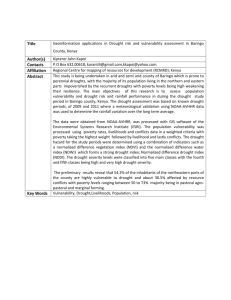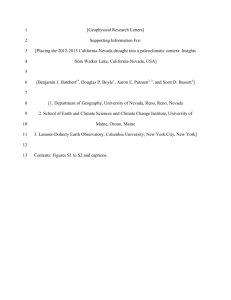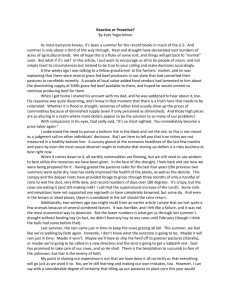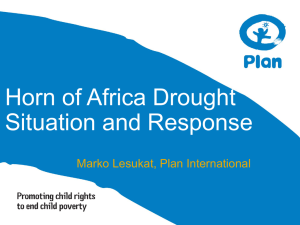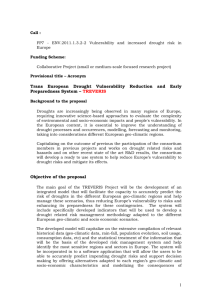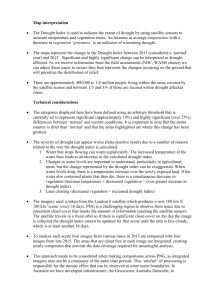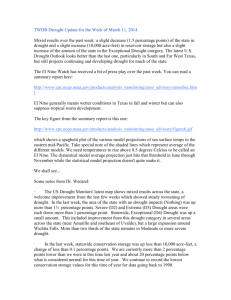WHAT SHOULD BE DONE ON DROUGHT
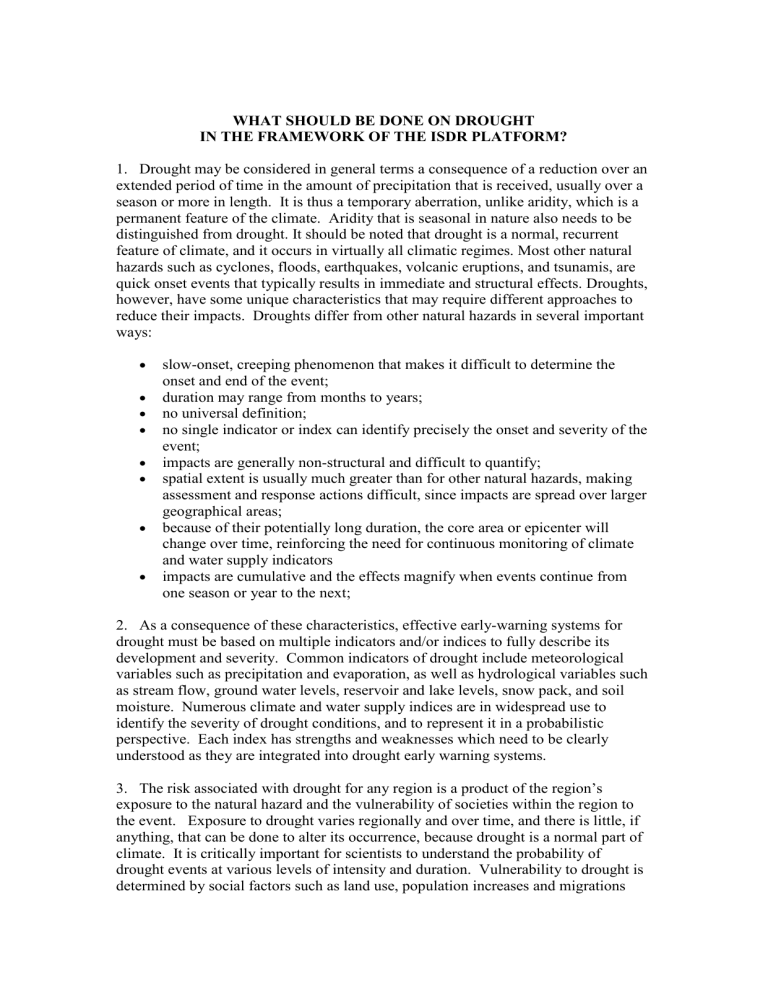
WHAT SHOULD BE DONE ON DROUGHT
IN THE FRAMEWORK OF THE ISDR PLATFORM?
1.
Drought may be considered in general terms a consequence of a reduction over an extended period of time in the amount of precipitation that is received, usually over a season or more in length. It is thus a temporary aberration, unlike aridity, which is a permanent feature of the climate. Aridity that is seasonal in nature also needs to be distinguished from drought. It should be noted that drought is a normal, recurrent feature of climate, and it occurs in virtually all climatic regimes. Most other natural hazards such as cyclones, floods, earthquakes, volcanic eruptions, and tsunamis, are quick onset events that typically results in immediate and structural effects. Droughts, however, have some unique characteristics that may require different approaches to reduce their impacts. Droughts differ from other natural hazards in several important ways:
slow-onset, creeping phenomenon that makes it difficult to determine the onset and end of the event; duration may range from months to years; no universal definition;
no single indicator or index can identify precisely the onset and severity of the event; impacts are generally non-structural and difficult to quantify; spatial extent is usually much greater than for other natural hazards, making assessment and response actions difficult, since impacts are spread over larger
geographical areas; because of their potentially long duration, the core area or epicenter will
change over time, reinforcing the need for continuous monitoring of climate and water supply indicators impacts are cumulative and the effects magnify when events continue from one season or year to the next;
2.
As a consequence of these characteristics, effective early-warning systems for drought must be based on multiple indicators and/or indices to fully describe its development and severity. Common indicators of drought include meteorological variables such as precipitation and evaporation, as well as hydrological variables such as stream flow, ground water levels, reservoir and lake levels, snow pack, and soil moisture. Numerous climate and water supply indices are in widespread use to identify the severity of drought conditions, and to represent it in a probabilistic perspective. Each index has strengths and weaknesses which need to be clearly understood as they are integrated into drought early warning systems.
3.
The risk associated with drought for any region is a product of the region’s exposure to the natural hazard and the vulnerability of societies within the region to the event. Exposure to drought varies regionally and over time, and there is little, if anything, that can be done to alter its occurrence, because drought is a normal part of climate. It is critically important for scientists to understand the probability of drought events at various levels of intensity and duration. Vulnerability to drought is determined by social factors such as land use, population increases and migrations
2 from one region to another or from rural to urban areas. Water use trends, environmental degradation, technological changes, and government policies can also alter vulnerability to drought. Vulnerability is dynamic and the factors mentioned above must be monitored to determine how changes in these factors may influence the impacts of future drought episodes.
Drought definition and types
4.
Absence of a precise and universally accepted definition of drought can lead to some confusion as to whether a drought exists and its severity. This uncertainty can lead to further confusion on the part of policy makers on whether or not to take action.
A comprehensive early warning system that relies on multiple indicators and indices can help to resolve this confusion and facilitate implementation of appropriate mitigation actions and response programs. Furthermore, drought is often forgotten once it ends, and consequently communities will again be ill-prepared when the next drought occurs. In the most drought-prone regions, drought may recur before the area has recovered from the most recent event.
5.
Many definitions of drought exist because the characteristics of drought differ between regions. Drought impacts also vary significantly between locations because of differences in economic, social, and environmental characteristics. Drought definitions should be impact or application specific and region specific. All droughts originate from a deficiency of precipitation. Three types of drought are commonly noted: meteorological, agricultural, and hydrological. Meteorological drought is principally defined by the deficiency of precipitation from expected or "normal" amount over an extended period of time. This type of drought is focused on the physical characteristics of drought, i.e., the departure of precipitation from normal, rather than on the impacts associated with this departure. Agricultural drought may be characterized by a deficiency in water availability for crop or plant growth.
Although precipitation deficiencies are important, agricultural drought severity is usually more closely associated with deficiencies in soil moisture, the most critical factor in defining crop production potential. Agricultural drought lags the occurrence of meteorological drought because it is associated with the level of soil water reserves in the soil profile. Some soils are more resilient to drought because of high water holding capacity. Vulnerability is highest on soils with a low water holding capacity, although appropriate soil management practices can reduce the impacts of drought on crops. Hydrological drought is best defined by deficiencies in surface and subsurface water supplies, which lead to a lack of water availability to meet normal and specific water demands. Hydrological or water supply drought lags the occurrence of agricultural drought because considerable time elapses between precipitation deficiencies and declines in ground water and reservoir levels. Likewise, these components of the hydrologic system are usually the last to recover from longer term droughts. There are clearly strong relationships between the three types of drought especially during prolonged periods of rainfall deficiency, although with leads and lags in terms of their respective onsets and departures.
Drought Early Warning Systems
6.
Because of the slow-onset nature of drought, it is essential that early warning systems have the capacity to detect the early emergence of rainfall deficiencies, which
3 will normally be the best indicator of an incipient drought period. There is a need for the application of tools or indices that have been recently developed and, in some cases, new tools/indices should be developed for specific applications to evaluate the status of climate and water supply conditions and potential impacts in specific sectors
(e.g., agriculture, wildfires). This information should be supplemented by long range forecasts out to a season or more whenever possible. A drought early warning system
(DEWS) must not only encompass mechanisms and procedures for the collection and analysis of information in a timely manner, but also for the dissemination of that information to potential end users, so that it can be applied in decision making. Once an incipient drought period is identified or forecast, there should be continuous information flow on expected onset and timing, intensity, cessation, duration, spatial extent and changes in areal coverage through time, and the estimation of economic, social, and environmental impacts. Meteorological, agricultural, and hydrological scientists need to better communicate how forecasts and other climate/water supply information can be used by decision makers in climate-sensitive sectors to reduce the risks associated with drought. These scientists should also solicit input from end users to better understand their need for information so climate-based products can be tailored to their specific needs.
7.
Drought early warning systems are an essential component of drought preparedness plans and policies, and the investigation of them is within the mandate of ISDR WG-2. A WMO expert group meeting recently identified several shortcomings of current DEWS that must be addressed for many nations to improve their level of preparedness to drought. These shortcomings included the following:
data networks
– inadequate density and data quality of meteorological and hydrological networks and lack of data networks on all major climate and water supply parameters;
data sharing – inadequate data sharing between government agencies and the high cost of data limit the application of data in drought preparedness, mitigation, and response;
early warning system products
– data and information products are often not user friendly and users are often not trained in the application of this information to decision making;
drought forecasts
– unreliable seasonal forecasts and the lack of specificity of information provided by forecasts limit the use of this information by farmers and others;
drought monitoring tools – inadequate indices for detecting the early onset and end of drought, although the Standardized Precipitation Index (SPI) was cited as an important new monitoring tool to detect the early emergence of drought;
integrated drought/climate monitoring
– drought monitoring systems should be integrated and based on multiple indicators to fully understand drought magnitude, spatial extent, and impacts;
impact assessment methodology – lack of impact assessment methodology hinders impact estimates and the activation of mitigation and response
programs; delivery systems – data and information on emerging drought conditions, seasonal forecasts, and other products are often not delivered to users in a timely manner;
4
global early warning system – no historical drought data base exists and there is no global drought assessment product that is based on one or two key indicators, which could be helpful to international organizations, NGOs, and others.
Reducing Drought Impacts
The mandate of ISDR WG 1 is focused on climate and natural disasters, and in view of the longer time-scales associated with drought, is especially relevant to this particular case of reducing drought-related disasters. The approach to drought in the past has been generally reactive and response oriented, i.e. through crisis management. Societal vulnerability to drought is increasing in many parts of the world because of the numerous factors mentioned previously, and this is an area of special focus for WG 3. One of the features of the climate system that has been linked with worldwide occurrences of extreme weather and climate events, such as droughts, floods and wildland fires (as noted by WG 4), is the El Niño/ Southern
Oscillation (ENSO) phenomenon; although it should be noted that the ENSO- phenomenon is not the only cause of the extreme weather and climate events.
Further, it has been noted, in particular by the Intergovernmental Panel on Climate
Change (IPCC), that in recent years and in some regions of the world, there is evidence of significant changes in the trend, frequency and intensity of some extreme climate events such as drought. This trend has led to the increased incidence of wildfires, food shortages, and other highly visible impacts in many sectors and regions.
Drought-prone regions should conduct a risk assessment to determine who and what is most at risk to drought and why. A vulnerability profile is an invaluable tool to have available as part of the drought planning process. The most vulnerable sectors, people, and regions can be systematically addressed as part of this planning process.
8.
During the coming decade and century, it is expected that, irrespective of changes in drought exposure, drought vulnerability will increase, mainly due to development pressures, population increases, and environmental degradation. Several efforts have therefore been made at international, regional and national levels to address the challenges of increasing drought risk. International and regional efforts include the drought monitoring, prediction early warning and disaster preparedness programmes and activities of organizations such as WMO, FAO, WFP, IFAD, IRI, ADPC,
ACMAD, DMCs (DMCH and DMCN), NOAA, USGS, and the U.S. National
Drought Mitigation Center.
9.
We have noted that, not only are droughts a natural component of the climate system that is recurrent, but also that drought-related hazards are expected to increase in the future. This increase in the drought hazard may result from an increased frequency and severity of meteorological drought, increased societal vulnerability to drought, or a combination of the two. It is the ISDR's mandate to be involved, in close collaboration with other relevant UN agencies and international, regional and national institutions, in efforts to reduce the impacts of climate related disasters including those associated with drought. In the area of drought preparedness and mitigation, there are a number of coordinated and collaborative initiatives that could be undertaken within the framework of the IATF and its four WGs on climate-related
disasters, early warning, vulnerability and impact assessment, and wildland fires respectively.
10.
Critical issues that could be addressed as integral parts of an ISDR initiative on drought include:
Supporting and strengthening the programmes for the systematic collection
and processing of meteorological and hydrological observations,
Building and strengthening scientific networks for the enhancement of scientific and technical capacities in meteorology, hydrology and other related fields,
Developing an inventory of water resources indicators and indices,
Development and dissemination of vulnerability/risk assessment tools
Vulnerability assessment under different environmental conditions,
Dissemination of drought planning methodologies that could be adopted by drought-prone countries in the preparation of plans,
Transfer of appropriate technology to developing countries,
Improved understanding of the drought climatology (frequency, intensity, and spatial extent) of drought patterns,
Understanding the principal causes of drought at local regional and global levels,
Development of standardized products / indicators for specific use, including hazards assessments,
Development of decision support models for the dissemination of droughtrelated information to end users and appropriate methods for encourage
feedback on climate and water supply assessment products,
Improvement of the monitoring, modeling and prediction capacities and improved communication of how this information can be applied in decision support,
Support all initiatives related to the promotion of Early Warning Systems,
Development of national and regional drought and disaster management policies,
Support development of regional networks for drought preparedness that would enhance regional capacity to share lessons learned in drought monitoring, prediction, preparedness, and policy development,
Development of comprehensive drought reduction strategies that emphasize monitoring and early warning, risk assessment, mitigation, and response as an essential part of drought preparedness,
Assessment of the availability of skilled human resources to be involved in drought preparedness planning,
Education and awareness of policy makers and the public regarding the importance of improved drought preparedness as a part of integrated water resources management,
Standardization of information to users; and need to recognize the role of
WMO, ISDR, regional institutions, NMHSs , etc,
Integration of local or indigenous coping mechanisms,
Enhancement of regional/international collaboration.
5
6
Recommendation to ISDR Task Force
11.
This short report provides a summary of the potential scope of areas that could be followed up within the framework of the ISDR. There is a need now for ISDR to identify some of the more urgent activities from the above list that could form the basis of a coherent and systematic process to tackle current and projected drought challenges. To launch such a process, which will not be independent of relevant programmes already underway or in planning, it is recommended that the tenure of the current ad hoc group of experts designated by the WGs be extended, with support from ISDR Secretariat. Given the uniqueness of drought as a natural hazard and the growing incidence of its occurrence in conjunction with changes in exposure and the number of people at risk, consideration should be given to creating a standing working group to focus on this topic, in collaboration with existing working groups.
One of the recurring themes of many of the issues identified above is the importance of networking to better share the experiences and lessons learned from various drought-prone regions and to promote the development and improvement of drought early warning systems, appropriate mitigation actions, preparedness planning methodologies, and risk-based drought management policies. The development of regional networks, based either on geographical proximity or homogeneity of drought climatology or impacts, represents a critical first step that deserves immediate attention. These networks can play a substantial role in the advancement of preparedness planning and the reduction in societal vulnerability to drought.

